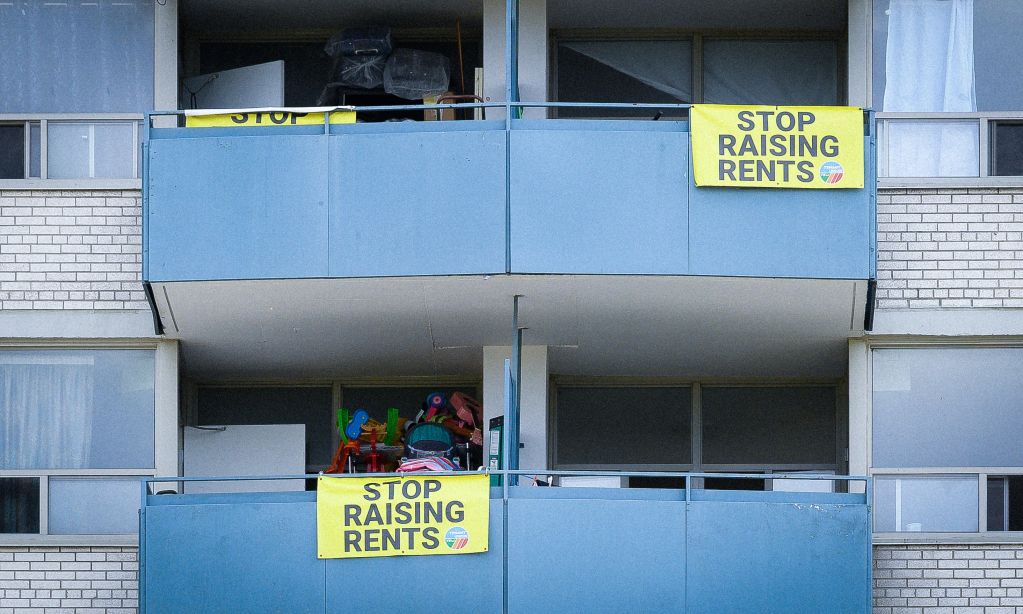Every June, the Ontario government announces the rent increase guideline for the following year. In theory, most rents cannot go up by more than this guideline. In practice, Ontario’s rent control rules have serious loopholes. As a result, in the past 10 years, average rent increases have outpaced approved guidelines—by a lot.
Between 2014 and 2023, Ontario’s annual rent increase guidelines officially allowed landlords to increase residential rents by 16.5 per cent. Yet over that period, average rents actually went up by 54.5 per cent, more than three times the guideline rate.1 As Figure 1 shows, in every year of this 10-year period, average rent increases were higher than those allowed by the rent increase guidelines.
In 2021, in response to the COVID-19 pandemic, the rent increase guideline was zero per cent. Nonetheless, average rents increased by 2.8 per cent that year. In 2022, the guideline increase was 1.2 per cent, but the average rent increase was 6.1 per cent—five times more. In 2023, average rents increased by 8.1 per cent despite a 2.5 per cent guideline.
Long gone are the days when skyrocketing rents were a Toronto problem. Figure 2 shows the accumulated average rent increases for 12 large cities in Ontario for which data are available. In all of them, the total average rent increase for the 2014-23 period was more than double the total rent guideline increase for the same period. The Ontario average is three times more.
In the past 10 years, average rents in Ontario have increased by more than three times the rent increase guideline.
In theory, Ontario has a relatively robust—if not as strong as some other provinces—system of rent controls. But in practice, that system has a wide array of built-in loopholes.
A brief history of rent controls in Ontario
In the mid-1970s, provinces enacted rent controls in response to pressure from the federal government. Some provinces, like Alberta, abandoned controls in the 1980s and never looked back. Other provinces, like Quebec, created stable regulations. In Ontario, successive governments changed the rules back and forth. Over time, rent control in the province became much weaker.
The Residential Premises Rent Review Act (1975) and the Residential Tenancies Act (1979) enacted second-generation rent control in Ontario. They set a maximum allowable rent increase rate of eight per cent in 1975 (inflation was 11 per cent that year) and six per cent in 1979 (inflation was nine per cent that year). Landlords could apply for higher increases, claiming financial hardship or low rates of return on investment.2 The Residential Rent Regulation Act (1985) pegged rent increase guidelines to the Consumer Price Index (CPI) up to a maximum of four per cent.3 The Act also enacted vacancy control.
In 1985, Ontario had the strongest rent control policies in the province’s history. It was a short-lived experiment. Starting in 1992, governments of all three major parties passed legislation that weakened rent control. As of 2024, Ontario has (i) vacancy decontrol; (ii) a date-based exemption that leaves tenants in units built after November 2018 without rent-increase protections; (ii) and AGI rules allowing landlords to pass on to tenants the entire cost of renovations, new security measures, and property tax increases above a certain limit. Landlords take advantage of these loopholes to raise rent above the guidelines and reach deeper into the pockets of tenant families.
Loophole: Vacancy decontrol
The Ontario government, under Mike Harris’s Progressive Conservative (PC) party, enacted vacancy decontrol in 1998. Since then, once a tenant vacates a unit, voluntarily or involuntarily, landlords can increase rents by however much they want—or “as much as the market will bear,” as some economists say. Since demand for housing is inelastic—people need housing regardless of how much it costs—landlords can increase rents by a lot, knowing people will sacrifice other needs and expenses to secure shelter. As a result, vacancy decontrol puts upward pressure on rents as a large share of all units sees high increases every year.
Table 2 shows that in Ontario, from November 2022 to November 2023, 10.8 per cent of all units saw a change of tenants. The average rent increase in these units was 35.6 per cent. In Toronto, the average rent increase in turnover units was 40.4 per cent. These large rent hikes on vacant units are one of the main factors pushing average rent increases above rent-increase guidelines.
Vacancy decontrol also creates a financial incentive for landlords to evict tenants, as landlords can considerably increase rent revenues at the turnover of units. The impact of this incentive was felt immediately after the 1998 change in legislation.
The immediate impact of vacancy decontrol
- Between 1997 and 2001, eviction applications jumped by 28 per cent in Ontario.4
- Between 1999 and 2000, eviction applications resulting from failed settlements between landlords and tenants jumped by 51 per cent, showing landlords’ diminished interest in keeping tenants.5
Between 1999 and 2000, there was also a 21 per cent increase in eviction applications based on reasons other than rent arrears.6 The “other reasons” category includes claims that tenants have damaged the property, regularly disturbed neighbours, done something illegal on the property, or had too many people living in a unit (overcrowding). It also includes “own use” applications, where landlords state that they, or a close family member, plan to move into the unit.
Since “other reasons” are less verifiable than rent in arrears, fraudulent evictions are usually filed in this category. As with most illicit activities, there is no good data on fraudulent evictions, but the 21 per cent jump following the enactment of vacancy decontrol could, at least in part, have been driven by landlords seeking to expel tenants to increase rents above the rent increase guidelines.
In recent years, there has been a noticeable upward trend in eviction applications for “other reasons.” In the 2009-10 fiscal year, applications based on “other reasons” made up 8.7 per cent of all eviction applications in Ontario, compared to 29.8 per cent in 2019-20. Since then, the share has dropped to 27.2 per cent—slightly lower but still three times the 2009-10 level.
These figures tell only part of the story. Eviction data doesn’t capture evictions that tenants didn’t fight at the Landlord and Tenant Board (LTB) or other tactics landlords use to displace tenants. The total number of legal and informal evictions is likely to be much higher.
Illegal “own use” evictions by small landlords are not the sole factor behind this trend. Recent research has shown that hiking rents on turnover units is not an isolated action by greedy landlords. On the contrary, it is both a common practice and an explicit investment strategy.
Vacancy decontrol allows investors to capitalize on the gap between the amount current long-term tenants pay and the potential for higher rents. Investors and landlords use various tactics to displace sitting tenants so they can charge new tenants more.7 This is particularly common in gentrifying areas where fast-growing property values increase the incentive to displace low-income tenants.8 Financialized landlords describe large, aging buildings with rents that fall below market levels as ideal investments with the most “allowance for future growth.”9
While the justification for vacancy decontrol is that landlords need to catch up with market rents, there is no evidence that high rent increases in turnover units reflect the increased costs of maintaining properties. Instead, they reflect landlords’ expectations of ever-growing returns on real estate investment. It may well be that vacant decontrol sets market rents rather than allowing rents to catch up with the market. In the contentious dynamic between landlords seeking growing profits and tenants trying to stay housed, vacancy decontrol clearly supports profit-maximizing goals.
Loophole: New unit and date-based exemptions
Some rent control regimes exempt new units for a set number of years. In Quebec, for example, new units are exempt for five years. This policy is usually defended as an incentive to boost supply. In practice, new units enter the market at the highest price point, as there is no price ceiling legislation anywhere in Canada.
New unit exemptions allow landlords to try to stay at the highest price point for as long as possible, at once spurring and benefiting from gentrification processes. New unit exemptions create insecurity for tenants as rent increases are unpredictable and often become more aggressive towards the end of the exemption period as landlords attempt to lock in high rents.
In 1992, Bob Rae’s NDP government approved a five-year exemption for newly built rental units. In 1998, Mike Harris’s PC government turned the new unit exemption into a date-based exemption: rent regulation no longer applied to units first occupied after November 1991. The Liberal government, under Dalton McGuinty, chose to preserve this regulation. In 2017, Kathleen Wynne’s Liberal government extended rent controls to all occupied units. A year later, the PC government under Doug Ford exempted all units first occupied after November 2018.
Adding to tenants’ financial insecurity is the fact that landlords have no legal requirement to inform tenants or state in lease agreements when a building was built or first occupied.10 This is important: once tenants have moved to and lived in a place for a year or more, they will assess rent increases against the financial and emotional costs of relocating. The lack of information at the time of signing the lease puts tenants in a weaker negotiating position down the road. This is yet another example of how current rules entrench the power of landlords.
The impact of uncontrolled increases in rent-control-exempt units is strong enough to impact rents at the city level. A recent study by CMHC found: “New unit exemption regimes lead to an increase in rental prices... The most likely explanation is that new unit exemptions lead to an increase in the number of uncontrolled units in the rental price index, which would cause the average rental price in the index to increase since these units are not subject to rent controls.”11 In other words, the more new units are exempted, the higher the rents.
In practice, date-based exemptions are a way for governments to abolish rent controls. It would be legally complicated to end rent controls suddenly because hundreds of thousands of active leases include them. Ending rent controls for all new leases would be less complicated but likely lead to tenants digging in their heels in rent-controlled units. Instead, governments exempt some units for some time, then extend exceptions, then extend them again. The five-year exemption approved in 1992 became a 25-year exemption in Ontario. In Manitoba, successive governments have extended the five-year exemption on new units to 15 years, then to 20 years. Over time, the share of regulated units shrinks, leading to a gradual but certain, quiet death to rent controls.






